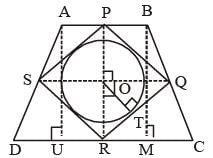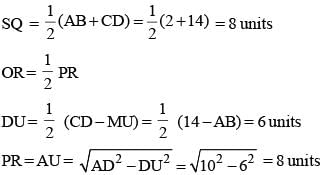CAT Exam > CAT Questions > ABCD is an isosceles trapezium with BC = AD =...
Start Learning for Free
ABCD is an isosceles trapezium with BC = AD = 10 units, AB = 2 units and CD = 14 units. The mid-points of the sides of the trapezium are joined to form a quadrilateral PQRS. Find the ratio of the area of the circle inscribed in the quadrilateral PQRS to the area of trapezium ABCD.
(2015)
- a)

- b)

- c)

- d)

Correct answer is option 'D'. Can you explain this answer?
| FREE This question is part of | Download PDF Attempt this Test |
Verified Answer
ABCD is an isosceles trapezium with BC = AD = 10 units, AB = 2 units a...

PQRS is a rhombus, so the centre of the inscribed circle will be the center of the rhombus PQRS

PR = SQ = 8 units
⇒ PQRS is a square

Area of trapezium =
 8 = 64 sq. unit.
8 = 64 sq. unit.Required ratio =

Most Upvoted Answer
ABCD is an isosceles trapezium with BC = AD = 10 units, AB = 2 units a...

PQRS is a rhombus, so the centre of the inscribed circle will be the center of the rhombus PQRS

PR = SQ = 8 units
⇒ PQRS is a square

Area of trapezium =
 8 = 64 sq. unit.
8 = 64 sq. unit.Required ratio =

Community Answer
ABCD is an isosceles trapezium with BC = AD = 10 units, AB = 2 units a...

PQRS is a rhombus, so the centre of the inscribed circle will be the center of the rhombus PQRS

PR = SQ = 8 units
⇒ PQRS is a square

Area of trapezium =
 8 = 64 sq. unit.
8 = 64 sq. unit.Required ratio =

Attention CAT Students!
To make sure you are not studying endlessly, EduRev has designed CAT study material, with Structured Courses, Videos, & Test Series. Plus get personalized analysis, doubt solving and improvement plans to achieve a great score in CAT.

|
Explore Courses for CAT exam
|

|
Similar CAT Doubts
ABCD is an isosceles trapezium with BC = AD = 10 units, AB = 2 units and CD = 14 units. The mid-points of the sides of thetrapezium are joined to form a quadrilateral PQRS. Find the ratio of the area of the circle inscribed in the quadrilateral PQRS to thearea of trapezium ABCD.(2015)a)b)c)d)Correct answer is option 'D'. Can you explain this answer?
Question Description
ABCD is an isosceles trapezium with BC = AD = 10 units, AB = 2 units and CD = 14 units. The mid-points of the sides of thetrapezium are joined to form a quadrilateral PQRS. Find the ratio of the area of the circle inscribed in the quadrilateral PQRS to thearea of trapezium ABCD.(2015)a)b)c)d)Correct answer is option 'D'. Can you explain this answer? for CAT 2024 is part of CAT preparation. The Question and answers have been prepared according to the CAT exam syllabus. Information about ABCD is an isosceles trapezium with BC = AD = 10 units, AB = 2 units and CD = 14 units. The mid-points of the sides of thetrapezium are joined to form a quadrilateral PQRS. Find the ratio of the area of the circle inscribed in the quadrilateral PQRS to thearea of trapezium ABCD.(2015)a)b)c)d)Correct answer is option 'D'. Can you explain this answer? covers all topics & solutions for CAT 2024 Exam. Find important definitions, questions, meanings, examples, exercises and tests below for ABCD is an isosceles trapezium with BC = AD = 10 units, AB = 2 units and CD = 14 units. The mid-points of the sides of thetrapezium are joined to form a quadrilateral PQRS. Find the ratio of the area of the circle inscribed in the quadrilateral PQRS to thearea of trapezium ABCD.(2015)a)b)c)d)Correct answer is option 'D'. Can you explain this answer?.
ABCD is an isosceles trapezium with BC = AD = 10 units, AB = 2 units and CD = 14 units. The mid-points of the sides of thetrapezium are joined to form a quadrilateral PQRS. Find the ratio of the area of the circle inscribed in the quadrilateral PQRS to thearea of trapezium ABCD.(2015)a)b)c)d)Correct answer is option 'D'. Can you explain this answer? for CAT 2024 is part of CAT preparation. The Question and answers have been prepared according to the CAT exam syllabus. Information about ABCD is an isosceles trapezium with BC = AD = 10 units, AB = 2 units and CD = 14 units. The mid-points of the sides of thetrapezium are joined to form a quadrilateral PQRS. Find the ratio of the area of the circle inscribed in the quadrilateral PQRS to thearea of trapezium ABCD.(2015)a)b)c)d)Correct answer is option 'D'. Can you explain this answer? covers all topics & solutions for CAT 2024 Exam. Find important definitions, questions, meanings, examples, exercises and tests below for ABCD is an isosceles trapezium with BC = AD = 10 units, AB = 2 units and CD = 14 units. The mid-points of the sides of thetrapezium are joined to form a quadrilateral PQRS. Find the ratio of the area of the circle inscribed in the quadrilateral PQRS to thearea of trapezium ABCD.(2015)a)b)c)d)Correct answer is option 'D'. Can you explain this answer?.
Solutions for ABCD is an isosceles trapezium with BC = AD = 10 units, AB = 2 units and CD = 14 units. The mid-points of the sides of thetrapezium are joined to form a quadrilateral PQRS. Find the ratio of the area of the circle inscribed in the quadrilateral PQRS to thearea of trapezium ABCD.(2015)a)b)c)d)Correct answer is option 'D'. Can you explain this answer? in English & in Hindi are available as part of our courses for CAT.
Download more important topics, notes, lectures and mock test series for CAT Exam by signing up for free.
Here you can find the meaning of ABCD is an isosceles trapezium with BC = AD = 10 units, AB = 2 units and CD = 14 units. The mid-points of the sides of thetrapezium are joined to form a quadrilateral PQRS. Find the ratio of the area of the circle inscribed in the quadrilateral PQRS to thearea of trapezium ABCD.(2015)a)b)c)d)Correct answer is option 'D'. Can you explain this answer? defined & explained in the simplest way possible. Besides giving the explanation of
ABCD is an isosceles trapezium with BC = AD = 10 units, AB = 2 units and CD = 14 units. The mid-points of the sides of thetrapezium are joined to form a quadrilateral PQRS. Find the ratio of the area of the circle inscribed in the quadrilateral PQRS to thearea of trapezium ABCD.(2015)a)b)c)d)Correct answer is option 'D'. Can you explain this answer?, a detailed solution for ABCD is an isosceles trapezium with BC = AD = 10 units, AB = 2 units and CD = 14 units. The mid-points of the sides of thetrapezium are joined to form a quadrilateral PQRS. Find the ratio of the area of the circle inscribed in the quadrilateral PQRS to thearea of trapezium ABCD.(2015)a)b)c)d)Correct answer is option 'D'. Can you explain this answer? has been provided alongside types of ABCD is an isosceles trapezium with BC = AD = 10 units, AB = 2 units and CD = 14 units. The mid-points of the sides of thetrapezium are joined to form a quadrilateral PQRS. Find the ratio of the area of the circle inscribed in the quadrilateral PQRS to thearea of trapezium ABCD.(2015)a)b)c)d)Correct answer is option 'D'. Can you explain this answer? theory, EduRev gives you an
ample number of questions to practice ABCD is an isosceles trapezium with BC = AD = 10 units, AB = 2 units and CD = 14 units. The mid-points of the sides of thetrapezium are joined to form a quadrilateral PQRS. Find the ratio of the area of the circle inscribed in the quadrilateral PQRS to thearea of trapezium ABCD.(2015)a)b)c)d)Correct answer is option 'D'. Can you explain this answer? tests, examples and also practice CAT tests.

|
Explore Courses for CAT exam
|

|
Suggested Free Tests
Signup for Free!
Signup to see your scores go up within 7 days! Learn & Practice with 1000+ FREE Notes, Videos & Tests.
























